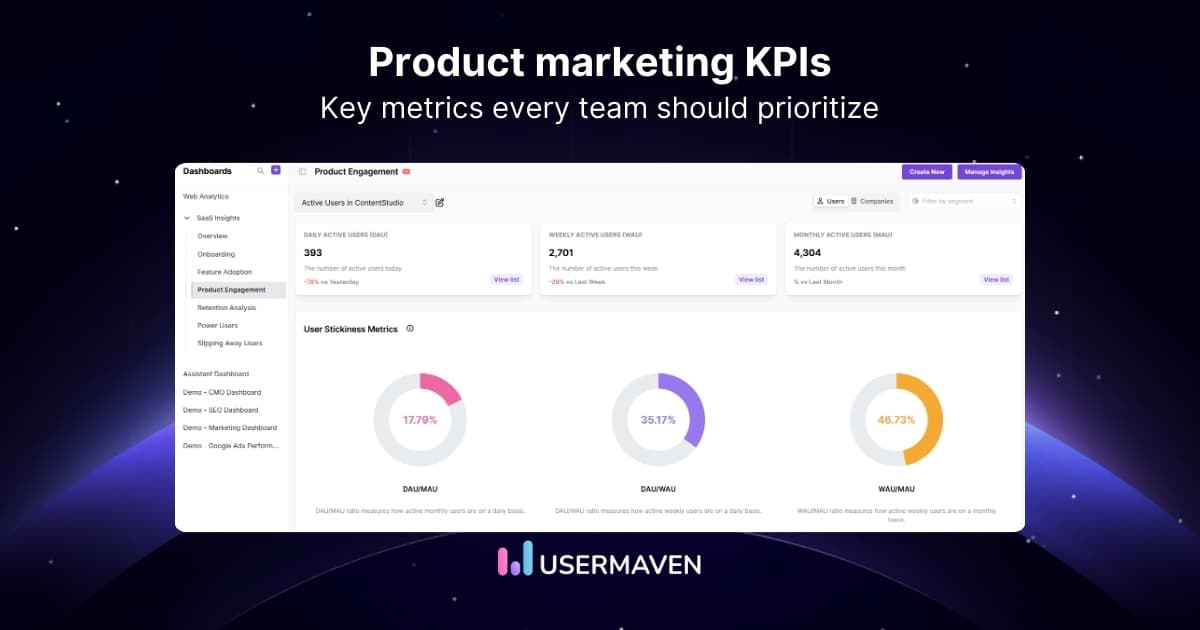What is user activation in SaaS & how to measure it
Apr 10, 2025
7 mins read
Written by Ameena Hassan

Not every new sign-up becomes a loyal user. In fact, most SaaS products lose users before they even get a chance to show their true value. That’s where user activation comes in, a crucial stage in the customer journey that bridges the gap between first interaction and long-term engagement.
For SaaS companies, the activation moment is more than a milestone; it’s a turning point. It’s when a new user experiences real value for the first time and decides whether your product is worth returning to. And the faster you can get them there, the better your chances of retaining them.
In this guide, we’ll break down what user activation really means, why it matters, how to measure it, and how to improve it. Plus, a few actionable strategies to boost your activation and retention rates. We’ll also show how tools like Usermaven can help you track and optimize this critical phase with clarity and ease.
What is user activation?
User activation is a key phase in the customer journey where new users engage with your product in a meaningful way, typically by completing a series of important actions that demonstrate its value. These actions vary depending on the product but often include steps like creating an account, exploring key features, or making an initial purchase.
The goal of user activation is to quickly help users experience the core benefits of your product so they understand how it solves their problems or meets their needs. By guiding users through these first steps and helping them realize the value of your product early on, you increase the chances of turning them into long-term, engaged users. A smooth and effective activation process not only boosts user retention but also contributes to higher conversion rates and improved customer satisfaction. Acquisition and activation need to work hand-in-hand to drive sustainable growth.
Why is user activation important for SaaS companies?
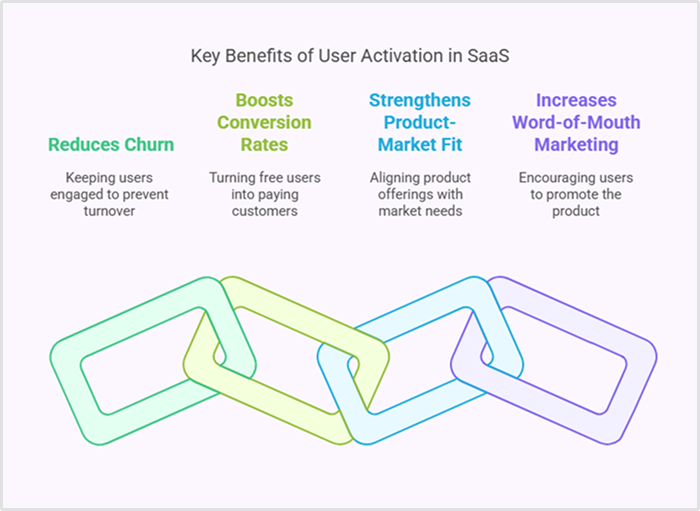
User activation is a critical factor that determines whether users will stick around, engage, and convert into loyal customers. When users quickly experience value from your product, they are more likely to continue using it and eventually pay for it. Let’s take a closer look at why user activation plays such a vital role in the success of SaaS companies.
Reduces churn
User activation directly impacts churn. If users don’t experience value quickly, they’re more likely to leave. However, users who activate early in their journey are far more likely to return and continue engaging with your product. By optimizing activation, you can effectively reduce churn and retain more users in the long run.
Boosts conversion rates
When users reach the activation point, they are more inclined to convert from free trials to paid plans. A streamlined activation process ensures that users are engaged and see the value of upgrading to a premium offering, leading to higher conversion rates and increased revenue.
Strengthens product-market fit
User activation also signals whether your product is solving the problems of your target market. A high activation rate suggests that your product aligns with user needs and is providing meaningful value. By improving user activation, you can refine your product to better meet market demands and improve retention.
Power up your SaaS
with perfect product analytics
*No credit card required
Increases word-of-mouth marketing
Activated users are more likely to recommend your product to others. Positive word-of-mouth from satisfied users can lead to organic growth, with new customers coming in through referrals. Activated users are your best advocates, so ensuring they reach that moment of value early can significantly boost your customer acquisition strategy.
In short, user activation is the key to retaining customers, boosting conversions, and creating a product that truly resonates with your audience. By optimizing this process, SaaS companies can set the stage for long-term success and continuous growth.
How to measure user activation?
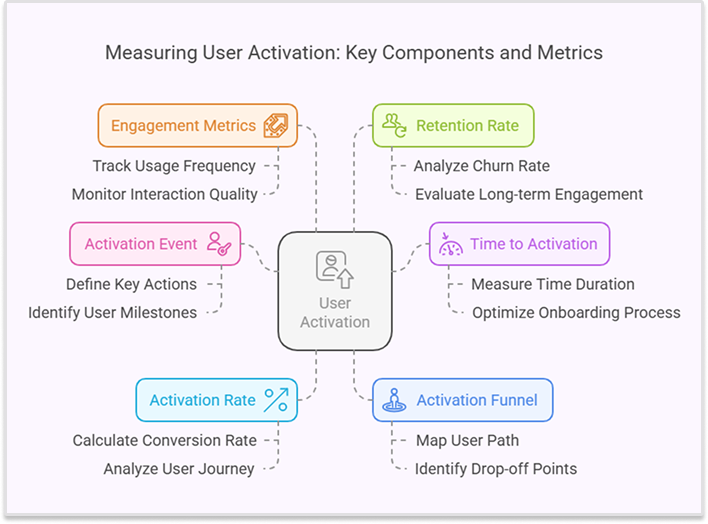
Measuring user activation is crucial to understanding whether your users are reaching the moment when they see value in your product. By tracking key metrics, you can optimize your process and ensure that users stay engaged. Here’s how to measure user activation effectively.
Define the activation event
The first step in measuring user activation is defining the “activation event” – the specific action that signifies a user has realized value. This could be anything from completing onboarding to using a key feature. For instance, in a SaaS tool, it could be creating a first report or engaging with a particular functionality. Defining this event will help you focus on what truly matters for activation.
Pro tip: With Usermaven, you can track and define activation events with ease. Their platform allows you to pinpoint the most impactful actions for your users, so you can make data-driven decisions that directly enhance activation rates.
Time to activation
Time to activation is the time it takes for a user to reach that activation moment after signing up. The faster users can reach activation, the better their chances of continuing to use your product. A quick time to activation indicates that users are getting value early on, which can boost retention rates.
Pro tip: Usermaven helps you track the time it takes for users to reach activation. By analyzing this metric, you can identify bottlenecks in your onboarding process and optimize it for faster user activation, ensuring your users get to value quickly.
Activation rate
The activation rate measures the percentage of users who reach the activation point relative to the number of total signups. This metric helps you understand how effective your onboarding process is. A low activation rate may indicate friction points in your product that prevent users from experiencing value.
Pro tip: With Usermaven, you can monitor your activation rate in real time and identify areas where users drop off. This data allows you to refine your onboarding process and improve overall activation rates.
Activation funnel
The activation funnel tracks how users progress through key steps of the onboarding process. By analyzing this funnel, you can identify where users drop off and optimize those stages to increase activation rates. Tools like Usermaven can provide a clear view of this funnel, helping you fine-tune each step of the user journey.
Pro tip: Usermaven offers detailed funnel tracking, allowing you to see exactly where users are getting stuck. This insight helps you streamline your onboarding process, reduce friction, and ultimately improve activation rates.
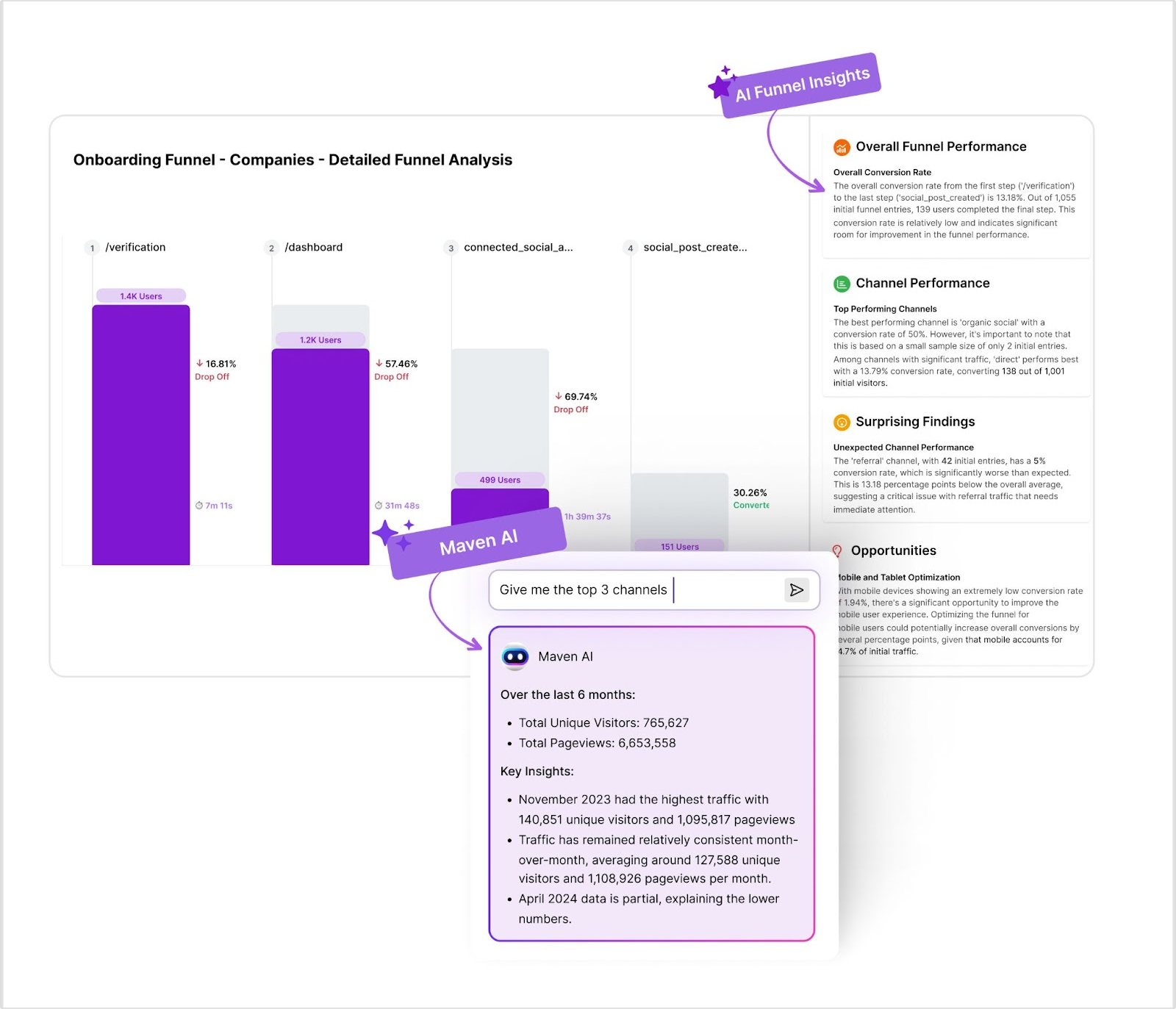
Engagement metrics
Engagement metrics, such as the number of sessions, feature usage, and active days, can help you measure user activation. If users are frequently engaging with core features, it’s a strong sign they’ve activated. These metrics provide deeper insights into how users are interacting with your product and how engaged they are after reaching the activation point.
Pro tip: Usermaven provides in-depth engagement tracking, giving you a clear view of how users interact with your product post-activation. This allows you to identify which features resonate most and further optimize your product to keep users engaged.
Retention rate
After users have been activated, it’s essential to measure the retention rate, the percentage of users who continue using your product after activation. A high retention rate indicates that users are finding lasting value in your product, making it essential to continually track this metric to ensure ongoing user success.
Pro tip: With Usermaven, you can monitor retention rates through cohort analysis over time and gain insights into how user behavior evolves post-activation. This data helps you identify opportunities to increase long-term engagement and minimize churn.
By leveraging Usermaven to track these key metrics, you can gain valuable insights into your user activation process and make informed decisions to improve retention, engagement, and long-term success.
10 user activation strategies to improve retention rates
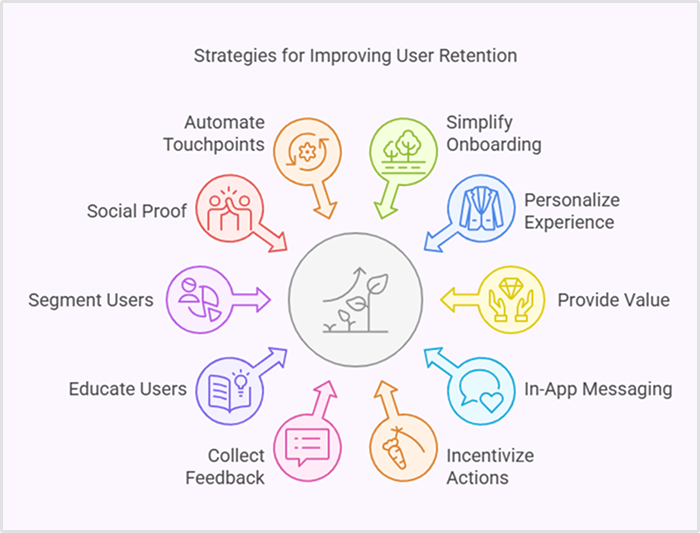
Improving user activation not only enhances user engagement but also directly impacts retention rates. When users experience value quickly, they’re more likely to continue using your product. Here are some proven strategies to improve user activation and boost retention.
1. Simplify the onboarding process
A streamlined onboarding process ensures that users quickly understand how to use your product and see its value. Avoid overwhelming them with too much information at once. Focus on the key features that will deliver immediate benefits.
Pro tip: Usermaven can help track user behavior during onboarding to identify where users drop off or get stuck, allowing you to simplify and optimize the process for better activation.
2. Personalize the experience
Personalization is key to making users feel that your product is tailored to their needs. Offer customized recommendations or personalized walkthroughs to help users get the most out of your product. The more relevant the experience, the more likely users are to stick around.
Pro tip: With Usermaven, you can analyze user behavior and tailor the user experience based on their actions and preferences, improving the relevance of your interactions and activation success.
3. Provide a clear value from the start
To boost activation, make sure that users experience value quickly. Whether it’s through a feature that solves an immediate pain point or a short tutorial that helps them complete a key task, showing value early on builds momentum.
Pro tip: Usermaven helps you track the exact moment users realize value, allowing you to refine your onboarding and feature delivery to maximize early engagement.
4. Use in-app messaging
In-app messaging can be an effective way to guide users and provide helpful tips as they use your product. By offering contextual help or nudges at the right time, you can help users reach their activation point faster.
Pro tip: Usermaven enables in-app messaging triggers based on user behavior, so you can send timely and relevant messages to drive user engagement and activation.
5. Incentivize key actions
Consider rewarding users when they complete key activation steps. Whether it’s offering a bonus feature, unlocking a new tool, or providing discounts for early engagement, incentives can motivate users to take the necessary actions that lead to activation.
Pro tip: Usermaven tracks user activity and can help you set up automated incentive programs to encourage users to engage with critical features and improve retention.
6. Collect and act on user feedback
Engagement and activation improve when users feel that their feedback is valued. Regularly ask for feedback and use it to improve your onboarding process or product features. By addressing user concerns promptly, you show that you are committed to their success.
Pro tip: Usermaven allows you to track digital analytics to see how users are interacting with your product. This data can help you adjust your activation process to be more user-centric.
7. Educate users with resources
Providing ongoing education helps users fully understand your product and its value. Offer resources such as tutorials, knowledge bases, or video guides that can help users navigate your product and achieve their goals.
Pro tip: Usermaven offers detailed analytics that can highlight which resources are being accessed most frequently, helping you identify what content will drive better user activation and retention.
8. Segment users based on behavior
Segmenting users based on their behavior allows you to deliver more targeted experiences. By focusing on the needs of specific user groups, you can increase the likelihood of successful activation and engagement.
Pro tip: Usermaven helps you segment users based on their behavior, allowing you to tailor activation strategies for different user groups and ensuring higher conversion and retention.
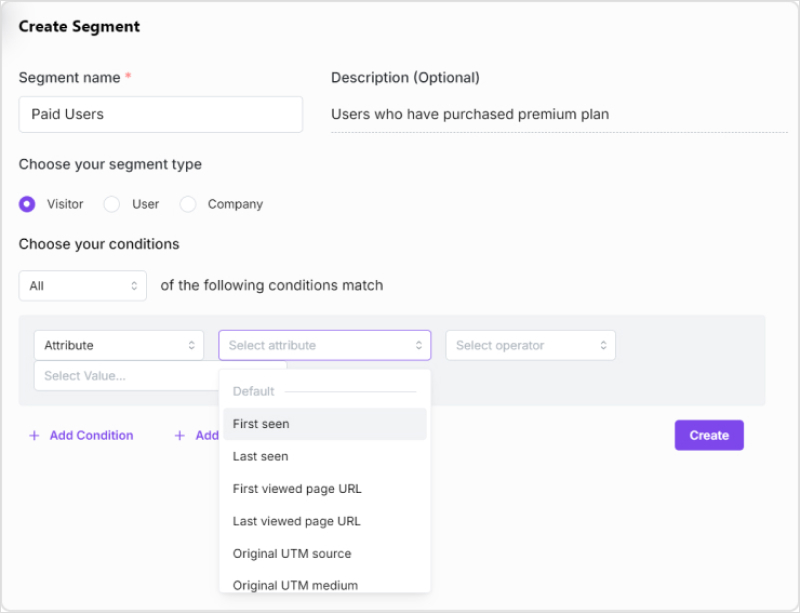
9. Enable social proof and community building
People are more likely to engage with a product that others recommend. Leverage social proof by showcasing testimonials, case studies, or user success stories to increase trust and engagement. Also, consider building a community where users can connect and share their experiences.
Pro tip: Usermaven tracks user journeys and behavior, helping you understand which success stories or features resonate with your users and enabling you to leverage social proof effectively.
10. Automate key touchpoints
Automation can help you stay engaged with users throughout their journey without overwhelming your team. Set up automated emails, push notifications, or in-app prompts to guide users through their activation process and encourage retention.
Pro tip: With Usermaven, you can automate personalized messaging and nudges based on user activity, making sure that every user receives timely prompts that guide them toward activation.
By implementing these strategies, you can significantly improve your user activation rates and increase retention. Tools like Usermaven can help you monitor these efforts and gather insights to continuously optimize your process, ensuring long-term user engagement and success.
Conclusion about user activation
User activation is a critical factor in the success of any SaaS business. By effectively guiding new users toward understanding your product’s value, you lay the foundation for increased engagement, retention, and overall growth. Implementing the strategies discussed, such as simplifying onboarding, personalizing experiences, and leveraging in-app messaging, can significantly enhance activation rates.
To ensure you’re making data-driven decisions and continuously optimizing your activation process, tools like Usermaven offer valuable insights and automation features. With the right approach, you can turn first-time users into loyal, long-term customers, helping your SaaS business thrive in a competitive market.
Power up your SaaS
with perfect product analytics
*No credit card required
FAQs about user activation
1. What is the difference between user activation and user acquisition in SaaS?
User acquisition focuses on bringing users to your platform, while user activation aims to get them engaged and realizing value quickly.
2. Why is user activation so important for retention?
Strong user activation increases engagement early on, making users more likely to return and use your product long-term.
3. How can I measure user activation in my SaaS product?
You can measure activation through metrics like first meaningful interaction, feature usage, and time to value.
4. How does onboarding impact user activation?
A streamlined and engaging onboarding process is key to helping users quickly see the value of your product, improving activation rates.
5. What role does personalization play in user activation?
Personalization tailors the experience to individual needs, making users feel more connected to the product and increasing activation.
6. How can I improve my SaaS product’s user activation rate?
Simplify onboarding, provide clear value from the start, and automate key touchpoints to guide users toward activation.
7. What are some common mistakes to avoid when working on user activation?
Overloading users with too much information or complex processes can delay activation and lead to drop-offs.
8. How does Usermaven help with user activation?
Usermaven provides powerful analytics and automation tools to track user behavior and personalize onboarding, helping to improve activation rates.
9. How do I build a user activation process for a new user?
Start by simplifying onboarding, offering clear value from the start, personalizing the experience, and using automation to guide users toward key actions.
10. Is user activation only relevant during onboarding?
No, user activation is an ongoing process that spans the entire user journey, from initial engagement to continued feature usage.
Try for free
Grow your business faster with:
- AI-powered analytics & attribution
- No-code event tracking
- Privacy-friendly setup
